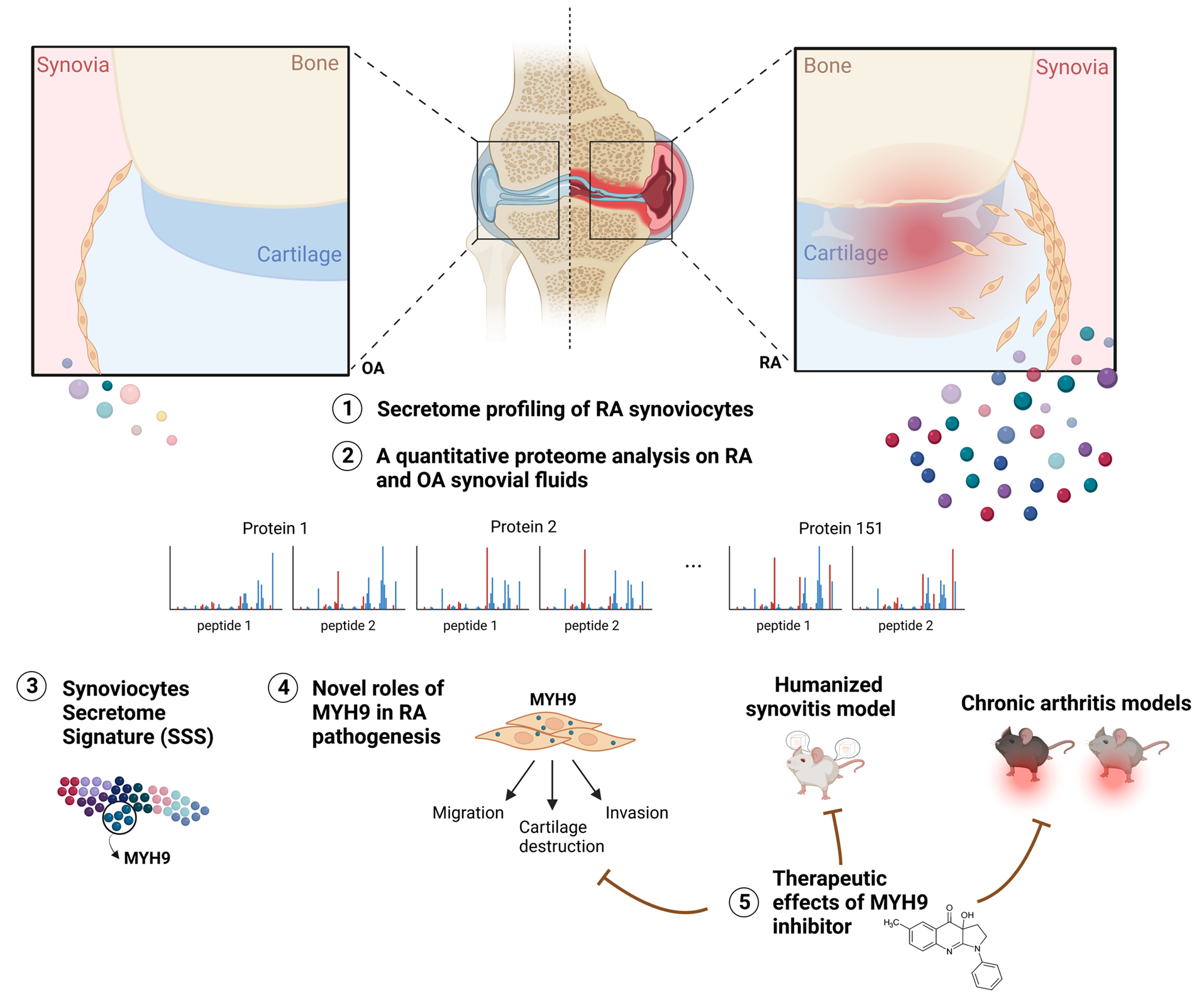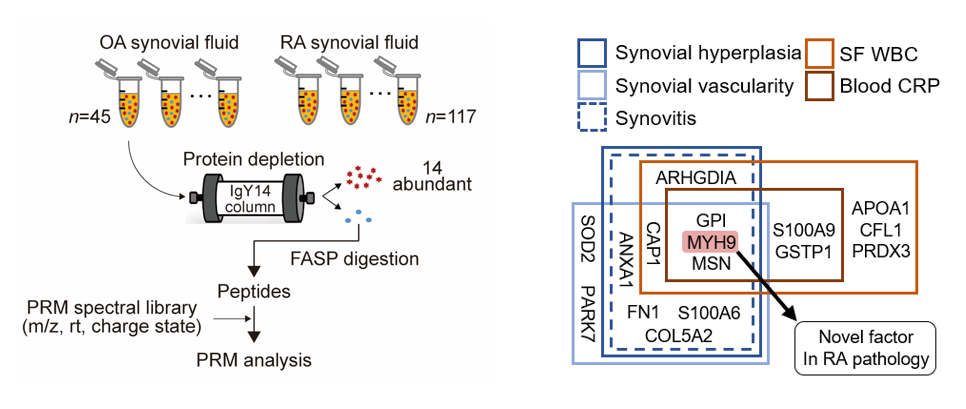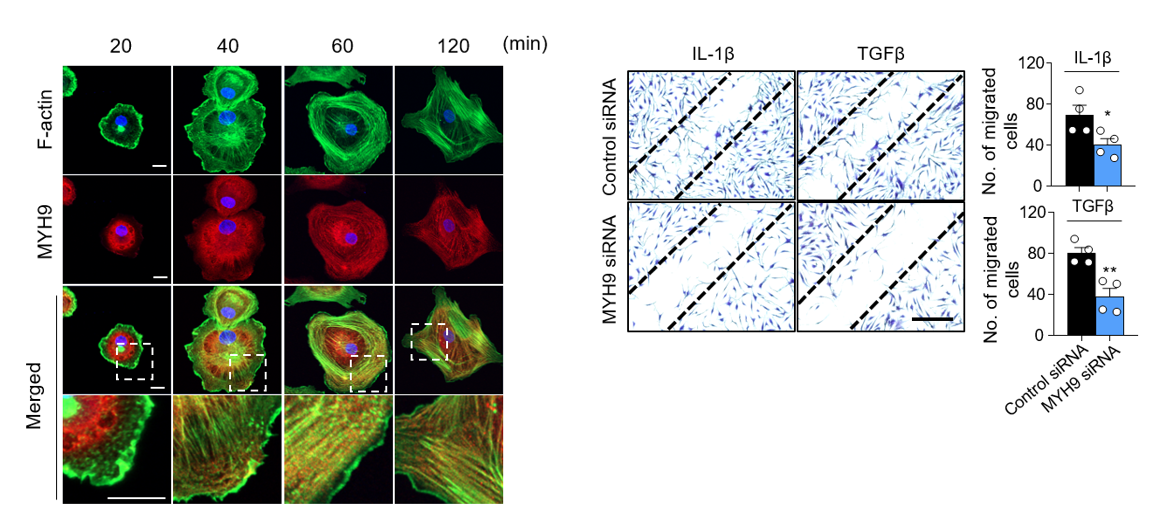-
Research Team Led by Dr. Kim Wanuk and Yoo Seungah Finds a New Rheumatoid Arthritis (RA) Diagnosis and Treatment MethodAuthor : 관리자Date : 2023.07.18Hit : 372
-
- Joint research with Prof. Hwang Daehee of SNU to identify the secretome profile of an invasive pannus, a pathological hallmark of RA
- World’s first to identify that myosin heavy chain 9 (MYH9) acts as a key regulator for synoviocyte migration and invasion
- Published in the world-renowned journal Annals of the Rheumatic Diseases (IF=28.003)
Dr. Kim Wanuk, director of the Center for Integrative Rheumatoid Transcriptomics and Dynamics at the Catholic University of Korea School of Medicine and professor of rheumatology at St. Mary's Hospital in Seoul, and his research team have identified 16 key proteins that are related to pannus, a a pathological hallmark of rheumatoid arthritis (RA), and its constituent cells, synoviocytes, in collaboration with Professor Hwang Daehee of the Seoul National University School of Life Sciences. The proteins were named “synoviocyte secretome signature (SSS)” and were reported to the academic world.
The findings of Dr. Kim Wanuk's team are expected to serve as a key resource for future research in the field, as they identified 16 key proteins secreted by the pathogenic tissue “pannus,” which plays a major role in inflammation and joint destruction of RA.
In particular, the researchers were the first in the world to identify the role of the key factor MYH9 in cell migration and invasion and to provide a new approach to treating RA with blebbistatin, a specific MYH9 inhibitor.
The findings open the door for more accurate diagnosis and effective treatment of RA in the future.
Pannus is one of the most important pathologic features of RA and is the main cause of joint destruction in patients with the disease. The rheumatoid arthritis fibroblast-like synoviocyte (RA-FLS) is a major component of the pannus, is highly proliferated in joints severely affected by RA, and plays a key pathogenic role by destroying cartilage and increasing inflammation. However, to date, there has been no comprehensive and holistic analysis of the proteins secreted by the pannus and its component cells, synoviocytes, considering the severity of the disease in actual RA patients.
Among the 16 SSS proteins proposed by Kim's team, MYH9 was identified as a novel protein that satisfied all criteria used for selecting the SSS but was not fully understood in RA, so it was further studied. MYH9 is known to be involved in a variety of cellular functions and behaviors through direct interactions with actin chains within the cell.
In RA, synoviocytes are well known for their migration and their ability to invade and destroy surrounding tissues. The research team led by Prof. Kim Wanuk showed that MYH9 coexists with actin chains in synoviocytes and was the first to discover that inhibiting MYH9 reduces migration and invasion of RA-FLSs.
Using blebbistatin, an inhibitor of MYH9, the researchers hope to provide a novel treatment for RA that targets MYH9. Specifically, blebbistatin led to less cartilage destruction in a humanized synovitis model, and in mouse models of chronic inflammatory arthritis, blebbistatin significantly reduced arthritis.
Under the heading "Identification of MYH9 as a key regulator for synoviocyte migration and invasion through secretome profiling," the study, which received funding from the National Research Foundation of Korea under the Ministry of Science and ICT, appeared in the prestigious rheumatology journal Annals of the Rheumatic Diseases (IF:28.003).
(Includes reference material and photos) (EOD).
[Reference material]
Reference 1. Identification of synoviocyte secretome signature (SSS) through secretome profiling of synovial fibroblasts of patients with RA and the role of myosin heavy chain 9 (MYH9) in RA-FLS invasiveness

Reference 2. A proteomic analysis of osteoarthritis (OA) and rheumatoid arthritis (RA) based on the analysis of proteins secreted by synoviocytes to obtain 16 key proteins

Reference 3. MYH9 coexists with an actin network that is actively modified during spreading, and synovial cell motility is reduced in MYH9-deficient conditions.

[Description for photos]
(From left) CUK College of Medicine Dr. Kim Wanuk, Prof. Yoo Seungah, Researchers Lee Saseong and Choi Eunbyeol (CUK graduate students)

-
Attachment File

